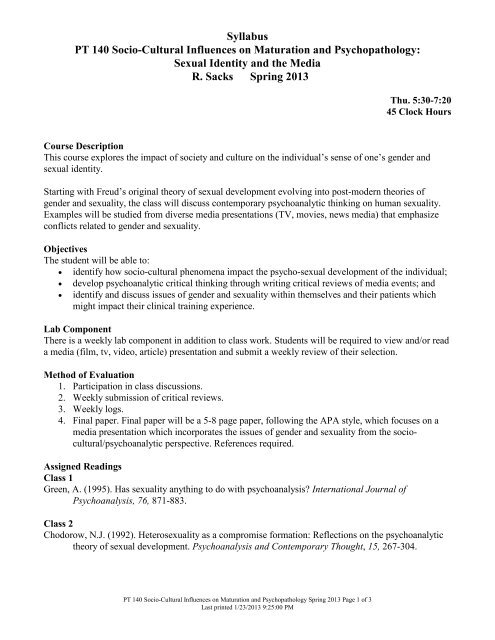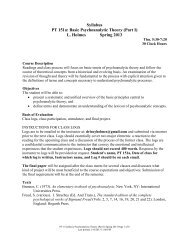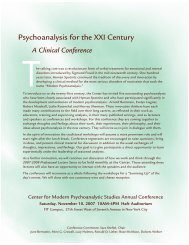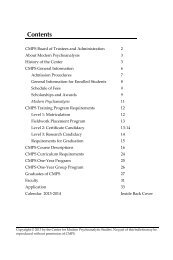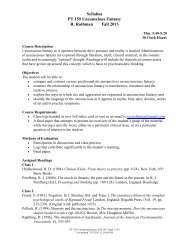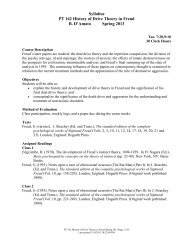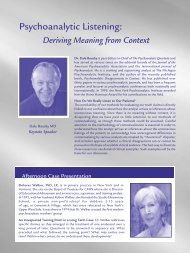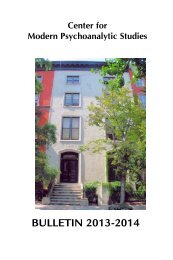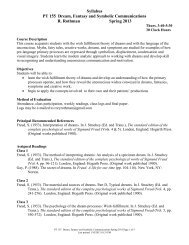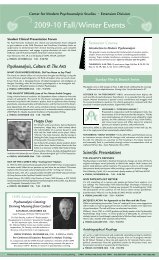Syllabus PT 140 Socio-Cultural Influences on Maturation and ...
Syllabus PT 140 Socio-Cultural Influences on Maturation and ...
Syllabus PT 140 Socio-Cultural Influences on Maturation and ...
Create successful ePaper yourself
Turn your PDF publications into a flip-book with our unique Google optimized e-Paper software.
<str<strong>on</strong>g>Syllabus</str<strong>on</strong>g><br />
<str<strong>on</strong>g>PT</str<strong>on</strong>g> <str<strong>on</strong>g>140</str<strong>on</strong>g> <str<strong>on</strong>g>Socio</str<strong>on</strong>g>-<str<strong>on</strong>g>Cultural</str<strong>on</strong>g> <str<strong>on</strong>g>Influences</str<strong>on</strong>g> <strong>on</strong> Maturati<strong>on</strong> <strong>and</strong> Psychopathology:<br />
Sexual Identity <strong>and</strong> the Media<br />
R. Sacks Spring 2013<br />
Thu. 5:30-7:20<br />
45 Clock Hours<br />
Course Descripti<strong>on</strong><br />
This course explores the impact of society <strong>and</strong> culture <strong>on</strong> the individual’s sense of <strong>on</strong>e’s gender <strong>and</strong><br />
sexual identity.<br />
Starting with Freud’s original theory of sexual development evolving into post-modern theories of<br />
gender <strong>and</strong> sexuality, the class will discuss c<strong>on</strong>temporary psychoanalytic thinking <strong>on</strong> human sexuality.<br />
Examples will be studied from diverse media presentati<strong>on</strong>s (TV, movies, news media) that emphasize<br />
c<strong>on</strong>flicts related to gender <strong>and</strong> sexuality.<br />
Objectives<br />
The student will be able to:<br />
• identify how socio-cultural phenomena impact the psycho-sexual development of the individual;<br />
• develop psychoanalytic critical thinking through writing critical reviews of media events; <strong>and</strong><br />
• identify <strong>and</strong> discuss issues of gender <strong>and</strong> sexuality within themselves <strong>and</strong> their patients which<br />
might impact their clinical training experience.<br />
Lab Comp<strong>on</strong>ent<br />
There is a weekly lab comp<strong>on</strong>ent in additi<strong>on</strong> to class work. Students will be required to view <strong>and</strong>/or read<br />
a media (film, tv, video, article) presentati<strong>on</strong> <strong>and</strong> submit a weekly review of their selecti<strong>on</strong>.<br />
Method of Evaluati<strong>on</strong><br />
1. Participati<strong>on</strong> in class discussi<strong>on</strong>s.<br />
2. Weekly submissi<strong>on</strong> of critical reviews.<br />
3. Weekly logs.<br />
4. Final paper. Final paper will be a 5-8 page paper, following the APA style, which focuses <strong>on</strong> a<br />
media presentati<strong>on</strong> which incorporates the issues of gender <strong>and</strong> sexuality from the sociocultural/psychoanalytic<br />
perspective. References required.<br />
Assigned Readings<br />
Class 1<br />
Green, A. (1995). Has sexuality anything to do with psychoanalysis Internati<strong>on</strong>al Journal of<br />
Psychoanalysis, 76, 871-883.<br />
Class 2<br />
Chodorow, N.J. (1992). Heterosexuality as a compromise formati<strong>on</strong>: Reflecti<strong>on</strong>s <strong>on</strong> the psychoanalytic<br />
theory of sexual development. Psychoanalysis <strong>and</strong> C<strong>on</strong>temporary Thought, 15, 267-304.<br />
<str<strong>on</strong>g>PT</str<strong>on</strong>g> <str<strong>on</strong>g>140</str<strong>on</strong>g> <str<strong>on</strong>g>Socio</str<strong>on</strong>g>-<str<strong>on</strong>g>Cultural</str<strong>on</strong>g> <str<strong>on</strong>g>Influences</str<strong>on</strong>g> <strong>on</strong> Maturati<strong>on</strong> <strong>and</strong> Psychopathology Spring 2013 Page 1 of 3<br />
Last printed 1/23/2013 9:25:00 PM
Class 3<br />
Drescher, J. (2011, September 25). Watching Chaz B<strong>on</strong>o dance with Lacey is not harmful to children.<br />
Retrieved from http://www.psychologytoday.com/blog/psychoanalysis-30/201109/watchingchaz-b<strong>on</strong>o-dance-lacey-is-not-harmful-children<br />
McDougall, J. (1995). Femininity <strong>and</strong> sexuality (Part I). In The many faces of eros (pp. 3-49). New<br />
York, NY: W.W. Nort<strong>on</strong>.<br />
ISS #1<br />
See a play. Go to a movie.<br />
Class 4<br />
Chodorow, N.J. (2012). Freud’s Three Essays <strong>on</strong> the Theory of Sexuality: A reading. In Individualizing<br />
gender <strong>and</strong> sexuality: Theory <strong>and</strong> practice (pp. 27-39). New York, NY: Routledge.<br />
McDougall, J. (1986). Identificati<strong>on</strong>s, ne<strong>on</strong>eeds <strong>and</strong> neosexualities. Internati<strong>on</strong>al Journal of<br />
Psychoanalysis, 67, 19-30.<br />
Class 5<br />
Bernstein, A. (2001). The genital psychoanalyst. Modern Psychoanalysis, 26, 191-201.<br />
Class 6<br />
Chodorow, N.J. (2012). Gender <strong>on</strong> the modern/postmodern <strong>and</strong> classical/relati<strong>on</strong>al divide: Untangling<br />
history <strong>and</strong> epistemology. In Individualizing gender <strong>and</strong> sexuality: Theory <strong>and</strong> practice (pp. 73-<br />
89). New York, NY: Routledge.<br />
Harris, A. (2005). Gender in linear <strong>and</strong> n<strong>on</strong>linear history. Journal of the American Psychoanalytic<br />
Associati<strong>on</strong>, 53, 1079-1095.<br />
Class 7<br />
D’Ercole, A. (2001). Postmodern ideas about gender <strong>and</strong> sexuality: The lesbian woman redundancy. In<br />
S. Kiersky <strong>and</strong> E. Gould (Eds.), Sexualities lost <strong>and</strong> found: Lesbians, psychoanalysis, <strong>and</strong> culture<br />
(pp. 179-195). Madis<strong>on</strong>, CT: Internati<strong>on</strong>al Universities Press.<br />
Class 8<br />
Kiersky, S. (2001). Exiled desire: The problem of reality in psychoanalysis <strong>and</strong> lesbian experience. In S.<br />
Kiersky <strong>and</strong> E. Gould (Eds.), Sexualities lost <strong>and</strong> found: Lesbians, psychoanalysis, <strong>and</strong> culture<br />
(pp. 25-42). Madis<strong>on</strong>, CT: Internati<strong>on</strong>al Universities Press.<br />
S<strong>and</strong>, S. (2001). Daring desire: Lesbian sexuality in popular music. In S. Kiersky <strong>and</strong> E. Gould (Eds.),<br />
Sexualities lost <strong>and</strong> found: Lesbians, psychoanalysis, <strong>and</strong> culture (pp. 237-246). Madis<strong>on</strong>, CT:<br />
Internati<strong>on</strong>al Universities Press.<br />
ISS #2<br />
Go to the movies.<br />
Class 9<br />
Benjamin, J. (1996). In defense of gender ambiguity. Gender <strong>and</strong> Psychoanalysis, 1, 27-43.<br />
Seccarelli, P. (1995). Transsexualism: Nature or counter-nature Internati<strong>on</strong>al Forum of Psychoanalysis,<br />
4, 25-33.<br />
Young-Bruehl, E. (2001). Are human beings “by nature” bisexual Studies in Gender <strong>and</strong> Sexuality, 2,<br />
179-213.<br />
<str<strong>on</strong>g>PT</str<strong>on</strong>g> <str<strong>on</strong>g>140</str<strong>on</strong>g> <str<strong>on</strong>g>Socio</str<strong>on</strong>g>-<str<strong>on</strong>g>Cultural</str<strong>on</strong>g> <str<strong>on</strong>g>Influences</str<strong>on</strong>g> <strong>on</strong> Maturati<strong>on</strong> <strong>and</strong> Psychopathology Spring 2013 Page 2 of 3<br />
Last printed 1/23/2013 9:25:00 PM
Class 10<br />
Mitchell, S.A. (1978). Psychodynamics, homosexuality, <strong>and</strong> the questi<strong>on</strong> of pathology. Psychiatry, 41,<br />
254-263.<br />
Mitchell, S.A. (1981). The psychoanalytic treatment of homosexuality: Some technical c<strong>on</strong>siderati<strong>on</strong>s.<br />
Internati<strong>on</strong>al Review of Psychoanalysis, 8, 63-80.<br />
Class 11<br />
Bollas, C. (1992). Cruising in the homosexual arena. In Being a character (pp. 144-165). New York,<br />
NY: Hill <strong>and</strong> Wang.<br />
Bruni, F. (2012, January 28). Genetic or not, gay w<strong>on</strong>’t go away. The New York Times. Retrieved from<br />
http://www.nytimes.com/2012/01/29/opini<strong>on</strong>/sunday/bruni-gay-w<strong>on</strong>t-go-away-genetic-ornot.html<br />
Class 12<br />
Chodorow, N. (2012). Homosexualities as compromise formati<strong>on</strong>s. In Individualizing gender <strong>and</strong><br />
sexuality: Theory <strong>and</strong> practice (pp. 155-174). New York, NY: Routledge.<br />
<str<strong>on</strong>g>PT</str<strong>on</strong>g> <str<strong>on</strong>g>140</str<strong>on</strong>g> <str<strong>on</strong>g>Socio</str<strong>on</strong>g>-<str<strong>on</strong>g>Cultural</str<strong>on</strong>g> <str<strong>on</strong>g>Influences</str<strong>on</strong>g> <strong>on</strong> Maturati<strong>on</strong> <strong>and</strong> Psychopathology Spring 2013 Page 3 of 3<br />
Last printed 1/23/2013 9:25:00 PM


